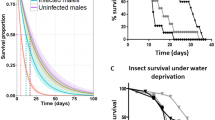Abstract
MOULTING in nematodes can be separated into two distinct processes: the deposition of the new cuticle and ecdysis, or the shedding of the old. This notion that the two events are distinct is supported by the work of Rogers and his colleagues1–3 on exsheathment in trichostrongyles. In Trichostrongylus and Haemonchus, the free-living second-stage larva deposits a new cuticle but fails to ecdyse in the absence of stimuli from the host. Thus the infective third stage larva remains ensheathed within the unshed second stage cuticle. Exsheathment, or ecdysis, is brought about by the release of an “exsheathing fluid” into the space between the new and old cuticles in response to a stimulus from the host. The exsheathing fluid is a complex system, but the component which appears to be responsible for digesting the old cuticle is the enzyme leucine aminopeptidase4. The suggestion that an endocrine link connects the reception of the stimulus from the host and the release of the exsheathing fluid by the parasite has been widely canvassed in the literature1,3,5–7, but there has been no evidence to support this attractive hypothesis.
This is a preview of subscription content, access via your institution
Access options
Subscribe to this journal
Receive 51 print issues and online access
$199.00 per year
only $3.90 per issue
Buy this article
- Purchase on Springer Link
- Instant access to full article PDF
Prices may be subject to local taxes which are calculated during checkout
Similar content being viewed by others
References
Rogers, W. P., The Nature of Parasitism (Academic Press, London and New York, 1962).
Rogers, W. P., and Sommerville, R. I., Parasitology, 50, 329 (1960).
Rogers, W. P., and Sommerville, R. I., in Advances in Parasitology (edit. by Dawes, B.), 1, 109 (Academic Press, London and New York, 1963).
Rogers, W. P., Comp. Biochem. Physiol., 14, 311 (1965).
Lee, D. L., The Physiology of Nematodes (Oliver and Boyd, Edinburgh, 1965).
Meerovitch, E., Canad. J. Zool., 43, 81 (1965).
Meerovitch, E., Proc. First Intern. Cong. Parasitology, 1, 681 (1966).
Myers, B. J., Canad. J. Zool., 38, 331 (1960).
Townsley, P. M., Wight, G. H., Scott, M. A., and Hughes, M. L., J. Fish. Res. Board, Canada, 20, 743 (1963).
Davey, K. G., Canad. J. Zool., 43, 997 (1965).
Davey, K. G., Canad. J. Zool., 42, 731 (1964).
Davey, K. G., Amer. Zoologist, 6, 243 (1966).
Ishikawa, M., Kiseichugaku Zasshi, 10, 1 (1961) (in Japanese: English summary).
Cameron, M. L., and Steele, J. E., Stain Technol., 34, 265 (1959).
Pearse, A. E., Histochemistry, Theoretical and Applied, second ed. (J. and A. Churchill, London, 1962).
Author information
Authors and Affiliations
Rights and permissions
About this article
Cite this article
DAVEY, K., KAN, S. Endocrine Basis for Ecdysis in a Parasitic Nematode. Nature 214, 737–738 (1967). https://doi.org/10.1038/214737a0
Issue Date:
DOI: https://doi.org/10.1038/214737a0
This article is cited by
Comments
By submitting a comment you agree to abide by our Terms and Community Guidelines. If you find something abusive or that does not comply with our terms or guidelines please flag it as inappropriate.



